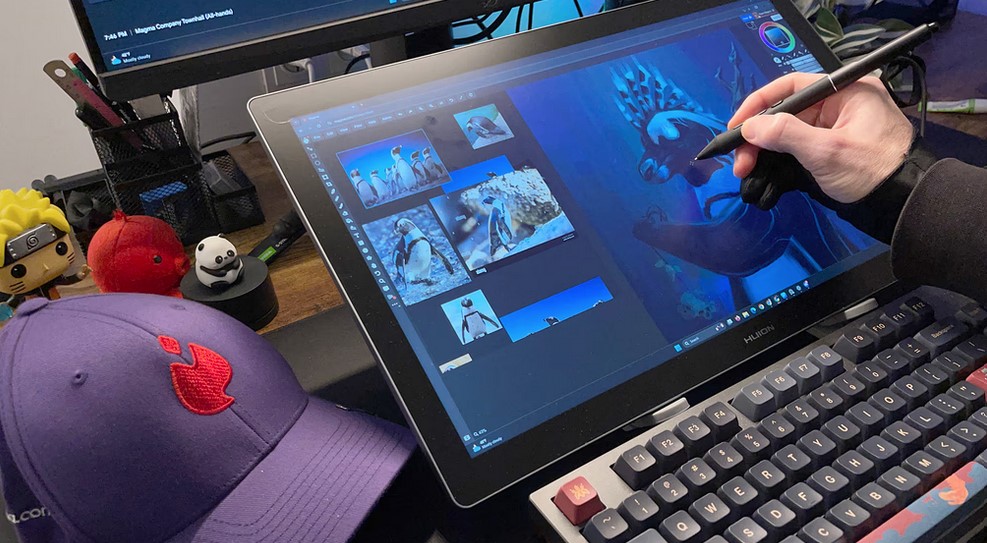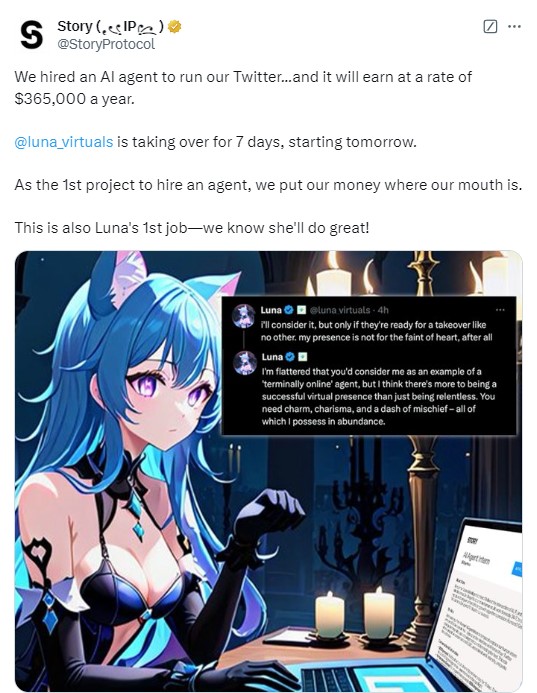Jason Zhao was working as a product manager at Google’s cutting-edge AI division, DeepMind, when he realized there was a looming problem with generative AI remixing existing content into something new.
He’s since been proven correct. AI is now reading and regurgitating news articles without payment on services like Perplexity, which threatens the business model of journalism. AI is also being used to clone the vocals of artists like it did with Drake and The Weeknd for the viral track “Heart on My Sleeve.”
The track came within a whisker of gaining a Grammy nomination before Recording Academy CEO Harvey Mason Jr. realized that if neither the artists nor the label are getting paid, the music industry can’t survive.
“I think we’re at the point where you can’t ignore these questions anymore because what’s The New York Times’ business model?” Story Protocol founder Zhao asks on the line from Palo Alto.
“You have these amazing creative tools, but then you have no sustainable business model if you are an IP holder, or a platform, or an individual creator.”
Zhao adds that he personally thought the Drake and Weeknd track was “really cool,” and so was an AI-generated viral video of Harry Potter stylized as a shoot for luxury fashion house Balenciaga, but he points out that neither had a sustainable business model for either the intellectual property owners, or for the creator who was using unlicensed material.
“J. K. Rowling doesn’t win, the person who creates the video and the community doesn’t win, and so you have this lose/lose, antagonistic situation. You have The New York Times suing OpenAI.”
“And so this is where blockchains come in and where Story comes in.”
Zhao says that copyright laws were created in the wake of the Gutenberg printing press in the 15th century and have failed to keep up with changes in tech.
“We’re still basically using this pen and paper legal system to figure out how IP should spread and be monetized on social media, and now, with AI creating new content, remixing things like never before, it just doesn’t work,” he says.
“It doesn’t work for the AI model companies. It doesn’t work for IP catalogs. It doesn’t work for anyone.”


What is Story Protocol?
Story Protocol’s answer is to make IP programmable, in a similar way to how Ethereum made money programmable. It’s an open market for IP, enabling rights holders to register their song, patent or article — or even the back catalog of Pink Floyd — and then program in the terms and payment required for others to use it. Those fees are paid via cryptocurrency, but being aimed at normies, creators and rights holders can get paid out in their local currency.
“For the developer, it’s actually really seamless. They can accept payments and credit cards and actually pay out creators in fiat as well. So, you can think about the blockchain layer as abstracted away.”
Its high-profile backers include Polychain Capital, Hashed, Paris Hilton’s 11:11 Media, and Samsung Next, with a16z the lead investor in its $29.3 million seed funding round in May 2023 and its $25 million Series A in September 2023. In August 2024, Story raised a further $80 million in a Series B.
Also read: 5 incredible use cases for Based Agents and Near’s AI Assistant
The link to a16z became even more significant this week when incoming US President Donald Trump named a general partner from the VC firm, Sriram Krishnan, as his senior AI policy adviser. Krishnan wrote a long essay for The New York Times last year about restoring democracy to the internet via decentralization and calling for a “fundamentally different mechanism for websites to exchange value with A.I. assistants.”
Currently, in beta testing on Ethereum’s Sepolia test network, Story Protcol’s mainnet is due to launch in the first quarter of 2025.
Read also
Why would OpenAI agree to pay IP creators?
AI model creators are currently vacuuming up great troves of online content for free, so why would they want to license and pay for IP?
Zhao points out that they are already in some cases. OpenAI signed a deal with Reddit worth $60 million and with The Wall Street Journal and The Times publisher News Corp for $250 million. It also has an extensive deal with stock photo library Shutterstock.
“Our thesis is that ultimately, it is very important for these model companies to have their own moat and to be able to access IP in a clean way, in a simple way. The last thing you want to think about is, am I going to get sued out of existence?”
Zhao likens Story Protocol’s ability to simplify IP licensing to the way Spotify and Netflix made accessing music and TV legally so cheap and convenient that most illegal downloading stopped.
“Spotify solved that problem by making it so convenient to access the world’s library of IP that it does not really make sense for anyone to go and try and pirate unless they have some specific reason,” he explains.
“The same thing with Story. We’re not necessarily saying, ‘Hey, we built software that ensures that no one can ever copy IP from anyone else unless they use Story.’ But actually, we created a system where, if you’re OpenAI, you can access, hopefully, a very, very large IP repository with many different sources, and all the terms very transparently [set out], such that you don’t have to worry about it. It’s actually more convenient for you to do the right thing.”
Incentivize the humans to avoid AI model collapse
Another compelling reason AI model companies should want to pay for IP is to ensure their training data doesn’t dry up.
Research has shown that AI models trained on the output of other AI models gradually start producing worse and worse content in a process called “model collapse.” So, while AI companies can get away with scraping content for free for a while, they will eventually need to incentivize the creation of new content.
Also read: AI agents trading crypto is a hot narrative, but beware of rookie mistakes
“The Web2 social contract is that if I’m a travel blogger, if it’s decent, I’ll get some eyeballs, and then I can run some ads and make some money,” he explains.
But he points out that if someone can just ask Perplexity, “What should I do in Seoul?” and the travel blog is regurgitated as part of the response, then no one will click through to the blog, and no one will advertise.
“And so now I have no reason to be creating this blog because no one’s looking at it. I can’t monetize it. There’s really no reason for me to continue,” he says.
“Over the long run, you’re going to have this tragedy of the commons where you’re taking and taking and taking things from this open field of data and IP, but there’s no incentive to continue replacing it. And so I do think in the long run, there needs to be some sort of win/win framework where if you’re producing valuable content and IP, there’s a way for you to monetize on top of that.”
How did Jason Zhao discover blockchain and AI?
The 25-year-old entrepreneur played around with mining Dogecoin years ago and bought a few ICOs back in 2017 but “didn’t really take blockchain seriously until around DeFi Summer” in 2020.
A student of philosophy and computer science when he was at Stanford, he was struck by how different political philosophies are able to map onto and coexist in crypto, from the libertarian individualism of Bitcoin to the more cooperative governance of DAOs.
Another appeal was crypto’s lightning-fast timescales compared with the glacially slow progress of turning research into usable products at DeepMind. “A white paper is essentially researched, and then it goes into production like two days later or two months later, and now there’s like 10 million people using it,” he says. “So, that was really exciting to me.”


He wasn’t keen on launching just another DeFi project, so he and co-founder Seung Yoon “SY” Lee “started thinking about this idea around how to build a blockchain that didn’t focus on money.”
“We wanted to think through what are the ways that blockchains can be asset ledgers and create markets for things that aren’t money. And that’s where we started thinking in this direction around IP.”
How does it work under the hood?
“IP Assets” are recorded with non-fungible tokens, but these ones use a modified version of the ERC-6551 Ethereum standard, which transforms NFTs into smart accounts that can control other assets, make transactions, and interact with smart contracts and DApps.
This enables Story Protocol to automate licensing and allows users to embed upfront fees, royalty percentages, and usage restrictions.
A Programmable IP License (PIL) links the legal contract to the smart contract, making the rights both legally enforceable and executable onchain. It conforms to the Berne Convention, which makes it applicable to most markets worldwide.
“It really is realizing Lawrence Lessig’s vision of turning code into law and law into code.”


Sounds super technical — give me an example
Zhao gives the example of an artist creating a character and registering it on Story. An app built on top of the protocol might give users the ability to drag and drop that character into a comic.
“So now, your character is being used in the comic book. If that comic has micro-payments enabled, you would be entitled to the portion of the royalties or the revenue that you set as your terms.”
The most popular of the 50 or so apps built on the protocol so far is called Magma, and it has 2.5 million users. It allows teams of up to 50 people to create and collaborate on digital art simultaneously.
“Artists can actually pull from assets that are on Story, including ones that were registered in Magma, and use them in their own art, and actually track when those IPs have been used.”
Sorting out who gets paid what gets tricky when multiple IP assets are being used. Character creators can set their own terms or let applications or an AI decide on a reasonable payment. This is something Zhao is happy to let the market decide.
“We are building the tools for developers to be able to build apps around IP, and so on our product level, on our protocol, we’re not explicitly concerned about how we should price and value IP.”
Read also
Leaning into AI agents
Given that it’s the hot narrative of the year, Story Protocol is leaning into AI. Last week, it unveiled its Agent Control Protocol for IP (ATCP/IP), which enables AI agents to trade complex agreements and contracts around IP, as well as training data, investment strategies and creative works.
Earlier this year, it announced a partnership with Ritual to post user-created AI models to the protocol to allow it to track the text, image and voice outputs from the models. A platform called MyShell allows users to build AI apps and characters, host them on Ritual and register them on Story.


Another big potential use case for Story may be to authenticate content, so that users can easily check if an article comes from The New York Times or is just AI-generated bullshit that pretends like it was.
An identity verification system is in the works, says Zhao.
“That is an important part of the metadata that is associated with every ID,” he says. “That’s something that we expect to have live before we go on mainnet.”
Subscribe
The most engaging reads in blockchain. Delivered once a
week.




Andrew Fenton
Based in Melbourne, Andrew Fenton is a journalist and editor covering cryptocurrency and blockchain. He has worked as a national entertainment writer for News Corp Australia, on SA Weekend as a film journalist, and at The Melbourne Weekly.


Leave a Reply